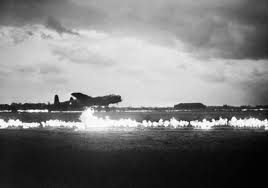
November 1943 |
19th |
Again this night William was detailed to Leverkusen for his second operation over Germany.
266 aircraft,- 170 Halifaxes, 86 Sterlings and 10 Mosquitoes – of 3, 4, 6 and 8 groups. Only 4 Halifaxes and 1 Sterling were lost. Very few German fighters were operating, probably because of bad weather at their airfields. Failures of the equipment prevented most of the Oboe marking being carried out and other Pathfinder aircraft were unable to mark the target properly in difficult weather conditions, leading to bombs being scattered over a wide area. At least 27 towns, mostly well to the north of Leverkusen, recorded bombs. Leverkusens own records show only one high-explosive bomb in the town.
It was mend to destroy the Chemical industry of the Bayer plant, the same as on August 22, 1943 and again on December 10/11, 1943.
Many of the aircraft returning from operations encountered fog conditions on reaching England and 2 Halifaxes and 1 Sterling crashed,but 4 Halifaxes of 35 Squadron landed safely at Graveley when the first operational use was made of the oil-burning fog-dispersal equipment called FIDO (Fog Investigation Dispersal Operation), which was installed at Graveley airfield. Several other airfields where soon fitted with this useful device. |
No.78 Squadron |
16 aircraft detailed for operations, Target: Leverkusen. November 19th 1943 This time the LW173, LW313, LW331, LW319, JP117, LW235, LW330, LW338, LW318, HR748, LW234, LW237, LW320, LW223, JD11 and, JD376 were made ready for operation in the late afternoon to Leverkusen. |
|
1 aircraft lost in action. |
Handley Page Halifax BII |
JP117 EY-Y
|
Lost in action |
JD118 EY-U |
F/S Hrynkiw's JD118 took off from Breighton Airport at 4:16 PM. Returned after the bombardment due to serious damage by Flak over Leverkust. On return it went out of control and crashed at North Cave, 10 miles south-west of Beverley Yorkshire. Navigator Sgt. W.A. Valley is buried in Harrogate (Stonefall) Cemetery. F/S W. Hrinkiw RCAF Sgt. S. Littler, F/S L.G.Preece RCAF Sgt. T. Stump, Sgt. W Jones. Sgt. G. Creer Injured but safe. |
Damaged |
LW223 EY-P |
It had taken off at 16:24 hours and after carrying out his bomb run, it was hit by a shell and returned damaged by heavy Flak, on returning to base it overshot the runway and finished up astride the railway line south of the village Bubwith. Luckily only Pilot F/O F.R. Harris and B/A Sgt. C. Watt were injured, but safe. The rest of the crew escaped uninjured. |
Damaged |
JD376 |
F/S Barton dropped his bombs 10 miles south-east of Leverkusen just before the Pathfinders dropped the T.I.s. Flak damage before the bombing, injured the navigator and bomb aimer. The JD 376 landed at Woodbridge Airport |
November 1943 |
20th |
No operations or standby for No.78 Squadron. |
21st |
No operations or standby for No.78 Squadron. |
November 19th 1943 |
Target Leverkusen |
Airborn: |
16:28 hour, Breighton Yorkshire. |
|
Bombing on: |
19.000ft at 19:23 hour. |
|
Landed: |
23:20 hour, Breighton Yorkshire. |
||
|
|
|
|
Crew JP117 EY-Y |
F/O Hudson, H. |
(Capt) |
|
F/O Robertson, W.J. |
(Nav) |
||
P/O Uyen, William |
(Bomb) |
||
Sgt. Monks, H. |
(W/Op) |
||
Sgt. Hillas, J. |
(F/Eng) |
||
|
P/O Lane, Jack |
(RG) |
|
|
Sgt. Morris, J. |
(MU) |
|
